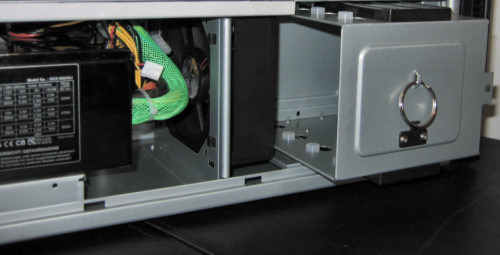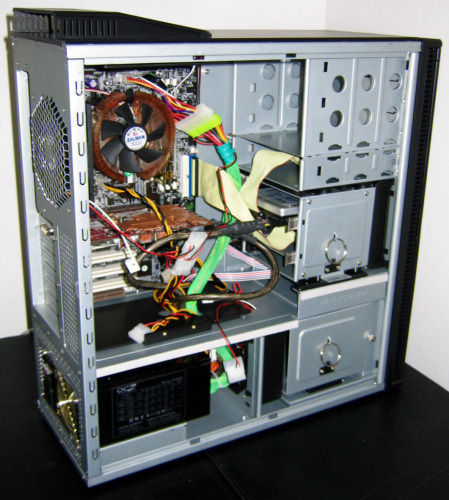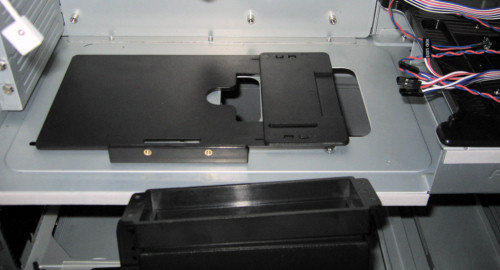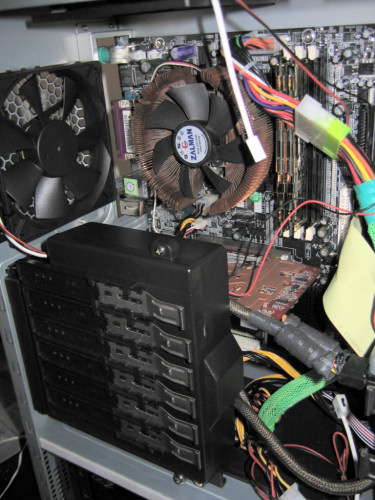Mid-Tower Mega Roundup
by Joshua Buss on September 8, 2005 12:05 AM EST- Posted in
- Cases/Cooling/PSUs
Antec P-180 (cont'd)
The P-180 ships with an unprecedented three 120mm fans, each of which has a switch identical to the ones that come with the Sonata. Out of the box, they are attached on the top panel pointing out, the rear panel pointing out, and the last is in the bottom chamber between where the power supply goes and the hard drive cage, directing air towards the power supply. Right away, we ran into a problem, however, with this third fan, as the power supply that we used for testing was too long to allow us to keep the fan where it was. To solve this problem, we made use of the case's fantastic customizability, and moved the fan to the other side of the bracket and turned it so that it was still blowing air towards the PSU. In this arrangement, it is no longer possible to put standard hard drives into the bottom drive cage, but there is still room for two in the upper cage anyway, so this was not a problem for us. In this picture, the bottom cage is half-way out, and the piece that holds the ring in place, both the upper and lower plastic rails on which the cage slides, as well as the tabs that the fan cage uses to hold the fan in place, are all visible.
The fact that we didn't use the included mounting bracket for the power supply is apparent from this picture as well, and the reason why is because we actually found it harder to fit out power supply into this bracket than just fastening it directly to the back plate. Ideally, this bracket's six rubberized strips could be used to keep vibrations from the power supply isolated, but our OCZ unit is rather quiet anyway.
As we mentioned earlier, the sheer design of this case - namely the decision to put the power supply at the bottom without inverting the motherboard - creates a potential problem: the motherboard power cables might be really tight, or unable to reach at all. With our Chaintech motherboard, we were actually testing just about the worst-case scenario, given that its power plug is at the very top of the board. Luckily, since we have to use the 24 to 20 pin adapter, our OCZ PowerStream power supply has enough cable to make the trip comfortably. This is definitely something to keep in mind, however, if one has an existing power supply and/or motherboard that they'd like to use in this case.
What is also visible in this picture is Antec's attempt at a system to isolate the two chambers thermally. The black plastic piece that the cables are going through can slide in two separate ways to make cable routing easier, but then slide back to provide a seal to keep the air moving only within each chamber.
Depending on one's particular setup, this cover could be used rather effectively or barely at all, depending on how many cables are needed to go through the two openings into the bottom chamber. For us, we must admit that we found the cover to be a bit more clumsy than useful, but this might not be the case for someone else.
One last piece to investigate with this case is the PCI card air duct. After everything else in the case was installed, the duct can be put into place and fastened through the back vent holes and at the bottom with two included bolts.
In our components picture on the previous page, the hole where an additional 80mm fan can be attached is visible, and it is this fan that would pull cool air from outside and direct it at the video and other cards to help keep them from getting too hot. Without the 80mm fan installed, the 120mm fans actually create enough suction to pull some air through this duct anyway - as long as they're on the medium or high speed setting - so purchasing an additional fan isn't totally necessary to make this duct usable. It also serves as the holder for the 5¼” drive rails, so losing them shouldn't be a problem; something that certainly can be in frequent traveling or uninstalling/reinstalling expeditions.
The P-180 ships with an unprecedented three 120mm fans, each of which has a switch identical to the ones that come with the Sonata. Out of the box, they are attached on the top panel pointing out, the rear panel pointing out, and the last is in the bottom chamber between where the power supply goes and the hard drive cage, directing air towards the power supply. Right away, we ran into a problem, however, with this third fan, as the power supply that we used for testing was too long to allow us to keep the fan where it was. To solve this problem, we made use of the case's fantastic customizability, and moved the fan to the other side of the bracket and turned it so that it was still blowing air towards the PSU. In this arrangement, it is no longer possible to put standard hard drives into the bottom drive cage, but there is still room for two in the upper cage anyway, so this was not a problem for us. In this picture, the bottom cage is half-way out, and the piece that holds the ring in place, both the upper and lower plastic rails on which the cage slides, as well as the tabs that the fan cage uses to hold the fan in place, are all visible.
The fact that we didn't use the included mounting bracket for the power supply is apparent from this picture as well, and the reason why is because we actually found it harder to fit out power supply into this bracket than just fastening it directly to the back plate. Ideally, this bracket's six rubberized strips could be used to keep vibrations from the power supply isolated, but our OCZ unit is rather quiet anyway.
As we mentioned earlier, the sheer design of this case - namely the decision to put the power supply at the bottom without inverting the motherboard - creates a potential problem: the motherboard power cables might be really tight, or unable to reach at all. With our Chaintech motherboard, we were actually testing just about the worst-case scenario, given that its power plug is at the very top of the board. Luckily, since we have to use the 24 to 20 pin adapter, our OCZ PowerStream power supply has enough cable to make the trip comfortably. This is definitely something to keep in mind, however, if one has an existing power supply and/or motherboard that they'd like to use in this case.
What is also visible in this picture is Antec's attempt at a system to isolate the two chambers thermally. The black plastic piece that the cables are going through can slide in two separate ways to make cable routing easier, but then slide back to provide a seal to keep the air moving only within each chamber.
Depending on one's particular setup, this cover could be used rather effectively or barely at all, depending on how many cables are needed to go through the two openings into the bottom chamber. For us, we must admit that we found the cover to be a bit more clumsy than useful, but this might not be the case for someone else.
One last piece to investigate with this case is the PCI card air duct. After everything else in the case was installed, the duct can be put into place and fastened through the back vent holes and at the bottom with two included bolts.














48 Comments
View All Comments
Abecedaria - Sunday, September 11, 2005 - link
What was the criteria for choosing these cases? Most of them look nasty-plasticy and even the Antec P-180, although it looks good, has a veery plasticy feel.Where was Silverstone in your review? They have some of the best cases available:
http://www.silverstonetek.com/product-case.htm">http://www.silverstonetek.com/product-case.htm
and from their new subsidiary:
http://www.tuniq.com.tw/Chassis/chassis.htm">http://www.tuniq.com.tw/Chassis/chassis.htm
These things rock.
abc
unclebud - Monday, September 12, 2005 - link
please consider reviewing the performance 640 next time?it currently includes a smartpower v2 400w, for $129
thanks in advance
Rudee - Saturday, September 10, 2005 - link
There is an error in the article. The Sonata II does indeed have a removable air filter in the front of the case, thus should not be given a score of "0" for this catagory.Tamale - Saturday, September 10, 2005 - link
The filter is removable from the bottom of the case only.. while this certainly is 'removable', it is nowhere near as accessible as the other cases which I gave this point to. I struggled with the idea of giving the case .5 for this category, but it wouldn't have made a difference in the end, and I really don't feel that most users would go through the trouble of tipping the case over just to clean the filter, so no points were awarded.Thanks for pointing out the detail though.
Rudee - Saturday, September 10, 2005 - link
The Sonata II case is great. I was able to overclock a AMD 64 3700 to 2700mhz using the stock AMD heatsink and fan with one Panaflo 92mm fan in the duct over the CPU. Temps are great and I ended up returning my Zalman 7700 as I didn't need it.dgkulzer - Friday, September 9, 2005 - link
After 1 month of use I am very happy with my P180. Assembly does take a bit longer than a standard case if you are trying to hide your cables but that isnt much of an issue to me. I put a Phantom 500 PSU in it and because its longer than most other PSU's I had to replace the lower fan with a thinner model (Nexus 120). I have 4 hard drives in the lower chamber and the Nexus at 5 volts keeps them very cool - I havent had the Phantom fan kick on yet either.This is one case that looks better in person than it does in pictures, the pictures make it look like a little fridge or something but it looks pretty sweet on your desk :)
mschira - Friday, September 9, 2005 - link
I guess the two compartment design is great for watercooling. You could put the pump reservoir etc in the lower compartment. If something leaks, the electronic is save.I think that's great thing...
M.
P.S. onla trouble is where to put the power suply...
Griswold - Friday, September 9, 2005 - link
Kids, having a flashy computer under your desk doesnt make the chicks like you more. Say no to stupid side windows!Tamale - Friday, September 9, 2005 - link
you seem to forget that most kids who think it would look cool to have the window in the first place probably don't care about girls anyway ;)p.s. - most people (girls included) seem to think my all-acrylic case is pretty cool
Griswold - Sunday, September 11, 2005 - link
Besides the total lack of EM shielding (which is enough reason to not do what you did, not only because it's not allowed in many countries (I know, I know, US is different, there, the cops wont stop you if your car has only 3 wheels..)), a full acrylic case is a nice show thingie. I just find side windows embarrassing, especially when the rest of the case looks like Optimus Prime's chest armor.